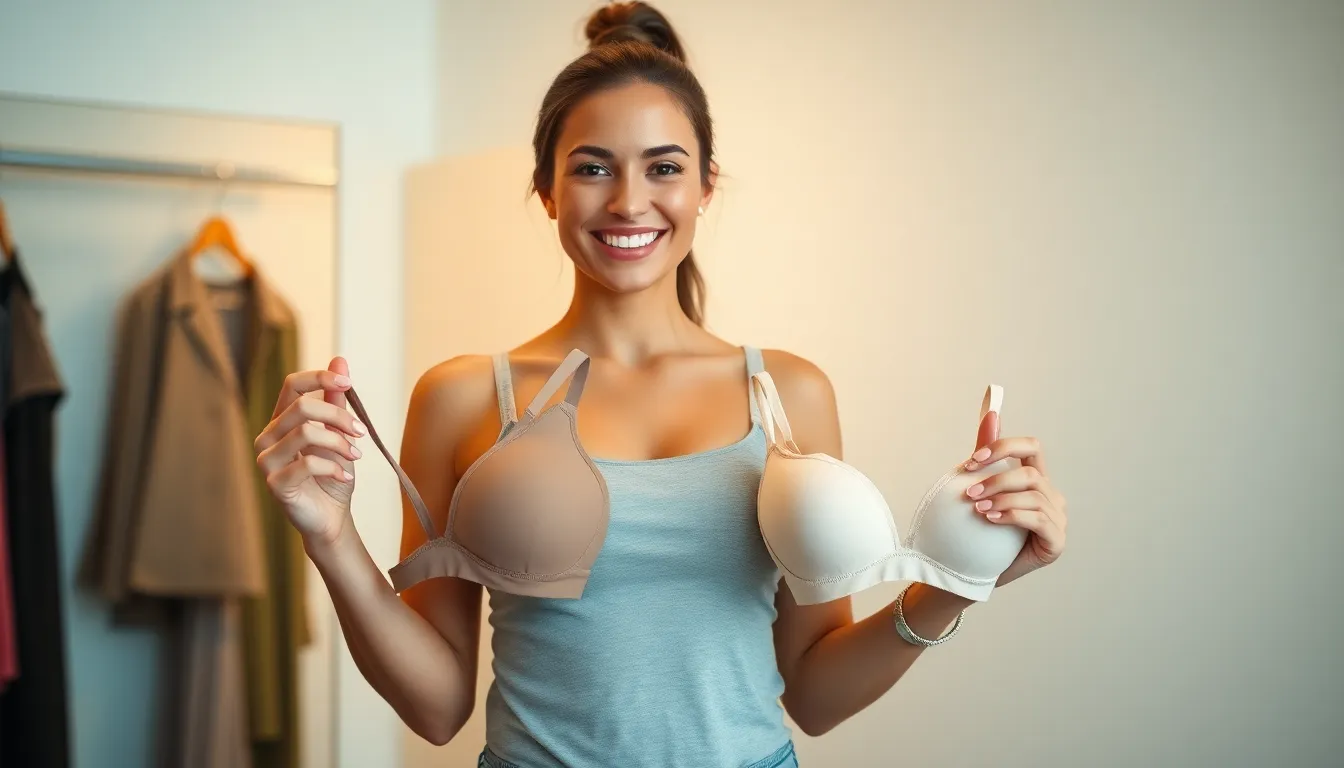When it comes to choosing the perfect bra size, the debate between A cup and B cup can feel like a high-stakes game of Goldilocks. One’s too small, the other’s just right—or is it? This playful rivalry has sparked countless conversations, and it’s time to dive into the details.
Table of Contents
ToggleOverview of A Cup vs B Cup
Bra sizes A and B represent different volumes and width measurements. A cup typically caters to individuals with smaller breast sizes, while B cup offers more volume. The key difference lies in the amount of breast tissue each size supports.
Measurements indicate that an A cup has approximately 1 cup size difference, fitting those with a lower bust measurement of around 31 to 33 inches. In contrast, the B cup accommodates a bust measurement ranging from 33 to 35 inches. This fundamental distinction affects fit, appearance, and overall comfort.
Many people find that cup volume also affects clothing fit. For example, tops might drape differently on A cup wearers compared to B cup supporters. Additionally, certain styles may enhance or diminish features based on cup size. Understanding the right fit optimizes overall wear experience.
Shopping for bras often requires trying different styles within these sizes. While some individuals prefer the natural look of an A cup, others might favor the additional shape of a B cup. Comfort plays a crucial role; therefore, testing various bras will help in selecting the best fit.
Choosing between A and B cups can also depend on personal preferences and body types. Many factors, such as body shape and silhouette, influence how each size looks and feels. To find the most suitable option, individuals should evaluate their comfort levels, desired styles, and overall aesthetic goals.
Key Differences Between A Cup and B Cup

Understanding the distinctions between A cup and B cup sizes enhances the selection process. These differences directly influence fit, comfort, and style.
Size Comparison
A cup sizes generally cater to individuals with smaller bust measurements. Measurements ranging from 31 to 33 inches typically correspond to A cups. B cup sizes, however, accommodate slightly larger bust dimensions. Individuals with measurements of 33 to 35 inches often find B cups provide a more suitable fit. The cup’s volume affects how clothing fits and drapes over the body. This variance in size impacts the overall aesthetic an individual aims to achieve.
Shape Variations
Shape plays a critical role alongside size in differentiating A cups from B cups. A cups feature a more shallow contour which results in a less pronounced silhouette. Conversely, B cups provide a fuller shape, which often enhances natural curves. Width and projection can also vary significantly between these cups. A cups maintain a softer curve, while B cups offer more volume and definition. Styles accommodating these variations can enhance or minimize appearance based on individual preferences and needs.
Psychological Aspects of Cup Sizes
Cup sizes impact psychological factors such as body image and confidence. Individuals often associate size with attractiveness and femininity, leading to varying perceptions.
Body Image Perception
Body image perception significantly influences how people view themselves. A cup and B cup sizes may evoke different feelings. Those with A cups might face societal pressures that associate larger sizes with beauty, potentially affecting self-esteem. In contrast, individuals with B cups may take pride in a fuller appearance, aligning with conventional beauty standards. Research shows that societal norms shape these perceptions, impacting mental health and overall confidence levels. Ultimately, personal experiences and environmental factors further complicate these associations.
Confidence Levels
Confidence levels correlate closely with cup size. People with larger sizes often express heightened self-assurance, feeling more attractive in their own skin. Studies indicate that this sense of empowerment can translate into various aspects of life, including social interactions and professional environments. Although not all individuals feel the same, many find that wearing a well-fitting, stylish bra enhances their confidence. In contrast, those with smaller sizes might grapple with feelings of inadequacy because of societal comparisons. Recognizing these feelings can lead to healthier self-acceptance, regardless of cup size.
Choosing the Right Cup Size
Selecting the appropriate cup size involves several essential factors. Personal comfort, style preferences, and body type significantly influence this choice.
Factors to Consider
Consider breast shape, as some may have rounder or more teardrop shapes. These variations can dictate how a bra fits and looks. Individuals should also think about their lifestyle. Active individuals might favor bras offering more support, while those prioritizing aesthetics may choose styles enhancing their silhouette. Additionally, it’s vital to account for the band size, as changes in this measurement can affect overall fit and support. Lastly, brand sizing can differ, making it crucial to try on multiple styles across various brands for the best result.
Impact on Comfort and Fit
Comfort significantly varies between A and B cups, and this dictates how a bra feels during wear. A cups generally offer less padding, which may be more comfortable for those preferring a lighter feel. This might lead to a better fit for smaller frames. B cups, however, provide more coverage and can create a snugger fit that some may find more supportive. Achieving the right balance often hinges on individual preference and activity level. A poorly fitting bra, regardless of cup size, can lead to discomfort and body image issues. Prioritizing comfort ensures a more confident and satisfying fit, reinforcing self-esteem and ensuring an enjoyable experience.
The choice between A cup and B cup sizes ultimately boils down to individual preferences and body types. Each size offers distinct advantages in terms of fit and comfort. While A cups provide a lighter feel and a less pronounced silhouette, B cups enhance natural curves and offer more coverage.
Understanding these differences can empower individuals to make informed decisions that align with their personal style and comfort. Embracing one’s unique shape and recognizing the impact of societal perceptions is vital for fostering self-acceptance. Ultimately, the right cup size is one that makes the wearer feel confident and comfortable in their own skin.




